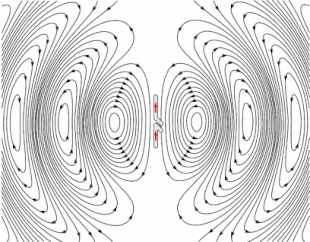Radio wave

Radio waves are a type of electromagnetic radiation with wavelengths in the electromagnetic spectrum longer than infrared light. Radio waves have frequencies as high as 300 GHz to as low as 3 kHz, though some definitions describe waves above 1 or 3 GHz as microwaves, or include waves of any lower frequency. At 300 GHz, the corresponding wavelength is 1 mm (0.039 in), and at 3 kHz is 100 km (62 mi). Like all other electromagnetic waves, they travel at the speed of light. Naturally occurring radio waves are generated by lightning, or by astronomical objects.
Artificially generated radio waves are used for fixed and mobile radio communication, broadcasting, radar and other navigation systems, communications satellites, computer networks and innumerable other applications. Radio waves are generated by radio transmitters and received by radio receivers. Different frequencies of radio waves have different propagation characteristics in the Earth's atmosphere; long waves can diffract around obstacles like mountains and follow the contour of the earth (ground waves), shorter waves can reflect off the ionosphere and return to earth beyond the horizon (skywaves), while much shorter wavelengths bend or diffract very little and travel on a line of sight, so their propagation distances are limited to the visual horizon.
To prevent interference between different users, the artificial generation and use of radio waves is strictly regulated by law, coordinated by an international body called the International Telecommunications Union (ITU), which defines radio waves as "electromagnetic waves of frequencies arbitrarily lower than 3 000 GHz, propagated in space without artificial guide".[1] The radio spectrum is divided into a number of radio bands on the basis of frequency, allocated to different uses.

Discovery and utilization

Radio waves were first predicted by mathematical work done in 1867 by Scottish mathematical physicist James Clerk Maxwell.[2] Maxwell noticed wavelike properties of light and similarities in electrical and magnetic observations. His mathematical theory, now called Maxwell's equations, described light waves and radio waves as waves of electromagnetism that travel in space, radiated by a charged particle as it undergoes acceleration. In 1887, Heinrich Hertz demonstrated the reality of Maxwell's electromagnetic waves by experimentally generating radio waves in his laboratory,[3] showing that they exhibited the same wave properties as light: standing waves, refraction, diffraction, and polarization. Radio waves were first used for communication in the mid 1890s by Guglielmo Marconi, who developed the first practical radio transmitters and receivers.
Propagation
The study of electromagnetic phenomena such as reflection, refraction, polarization, diffraction, and absorption is of critical importance in the study of how radio waves move in free space and over the surface of the Earth. Different frequencies experience different combinations of these phenomena in the Earth's atmosphere, making certain radio bands more useful for specific purposes than others. Practical radio systems use three different techniques of radio propagation to communicate:
- Line of sight: This refers to radio waves that travel in a straight line from the transmitting antenna to the receiving antenna. It does not necessarily require a cleared sight path; at lower frequencies radio waves can pass through buildings, foliage and other obstructions. This is the only method of propagation possible at microwave frequencies and above. On the surface of the Earth, line of sight propagation is limited by the visual horizon to about 40 miles. It is the method used in short range radio communication systems such as cell phones, walkie-talkies, wireless networks, FM and television broadcasting and radar. By using dish antennas to transmit beams of microwaves, point-to-point radio relay links transmit telephone and television signals over long distances up to the visual horizon, and ground stations can communicate with satellites and spacecraft billions of miles from Earth.
- Ground waves: At lower frequencies, in the medium wave and longwave bands, due to diffraction vertically polarized radio waves can bend over hills and mountains, and propagate beyond the horizon, traveling as surface waves which follow the contour of the Earth. This allows mediumwave and longwave broadcasting stations to have coverage areas beyond the horizon, out to hundreds of miles. As the frequency drops, the losses decrease and the achievable range increases. Military very low frequency (VLF) and extremely low frequency (ELF) communication systems can communicate over most of the Earth, and with submarines hundreds of feet underwater.
- Skywaves: At medium wave and shortwave wavelengths, radio waves reflect off a conductive ionized layer in the atmosphere called the ionosphere. So radio waves directed at an angle into the sky can return to Earth beyond the horizon; this is called "skip" or "skywave" propagation. By using multiple skips communication at intercontinental distances can be achieved. This technique is used by military over-the-horizon (OTH) radar systems, by radio amateurs, and by shortwave broadcasting stations to broadcast to other countries. Skywave propagation is variable and dependent on atmospheric conditions; it is most reliable at night and in the winter.
Speed, wavelength, and frequency
Radio waves travel at the speed of light.[4][5] When passing through an object, they are slowed according to that object's permeability and permittivity.
The wavelength is the distance from one peak of the wave's electric field (wave's peak/crest) to the next, and is inversely proportional to the frequency of the wave. The distance a radio wave travels in one second, in a vacuum, is 299,792,458 meters (983,571,056 ft) which is the wavelength of a 1 hertz radio signal. A 1 megahertz radio signal has a wavelength of 299.8 meters (984 ft).
Radio communication
In order to receive radio signals, for instance from AM/FM radio stations, a radio antenna must be used. However, since the antenna will pick up thousands of radio signals at a time, a radio tuner is necessary to tune in a particular signal.[6] This is typically done via a resonator (in its simplest form, a circuit with a capacitor, inductor, or crystal oscillator, but many modern radios use Phase Locked Loop systems). The resonator is configured to resonate at a particular frequency, allowing the tuner to amplify sine waves at that radio frequency and ignore other sine waves. Usually, either the inductor or the capacitor of the resonator is adjustable, allowing the user to change the frequency at which it resonates.[7]
See also
Notes
- ^ ITU Radio Regulations, Chapter I, Section I, General terms – Article 1.5, definition: radio waves or hertzian waves
- ^ Harman, Peter Michael (1998). The natural philosophy of James Clerk Maxwell. Cambridge, England: Cambridge University Press. p. 6. ISBN 0-521-00585-X.
- ^ "Heinrich Hertz: The Discovery of Radio Waves". Juliantrubin.com. Retrieved 2011-11-08.
- ^ http://www.1728.org/freqwave.htm
- ^ http://www.nrao.edu/index.php/learn/radioastronomy/radiowaves
- ^ Brain, Marshall (2000-12-07). "How Radio Works". HowStuffWorks.com. Retrieved 2009-09-11.
- ^ Brain, Marshall (2000-12-08). "How Oscillators Work". HowStuffWorks.com. Retrieved 2009-09-11.
References
- James Clerk Maxwell, "A Dynamical Theory of the Electromagnetic Field", Philosophical Transactions of the Royal Society of London 155, 459-512 (1865).
- Heinrich Hertz: "Electric waves; being researches on the propagation of electric action with finite velocity through space" (1893). Cornell University Library Historical Monographs Collection. Reprinted by Cornell University Library Digital Collections.
- Karl Rawer: "Wave Propagation in the Ionosphere". Kluwer, Dordrecht 1993. ISBN 0-7923-0775-5

